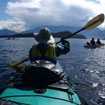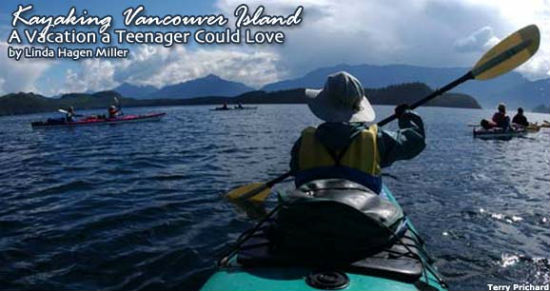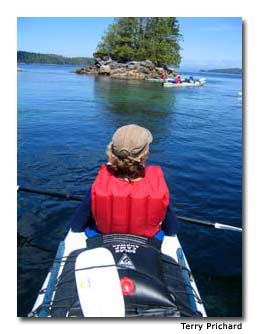

We’ve paddled our kayaks to Little Kaikash Beach on the east coast of Vancouver Island, and are sitting on the rocks eating lunch when one of the guides shouts: “Whales!”A pod of orcas appears in the distance, then another and another. Food scatters and we jump into our kayaks and paddle out.The whales are surfacing and blowing, gliding between fishing boats, when one group veers toward our cove. They’re really coming this way … they’re within 100 yards … they’re so close we can hear them blow.Suddenly a big male cuts toward us. Out of nowhere a purse seiner barrels between our kayaks and the lone orca, chasing him away. It’s breathtaking, maddening and totally worth the price of admission. The teenagers have lost all trace of blasé cool, and everyone’s whooping and oh-wowing at the display.
We’re on a guided six-day camping and kayaking trip with Sea Kayaking Adventures in Johnstone Strait, between mainland British Columbia and Vancouver Island.
The mountains on Vancouver Island look massive enough to sink the island, and across the channel, mainland British Columbia’s snow-dusted peaks hunker in the distance.
The water and the sky are competing with each other for the finest shade of blue, the beaches are nearly empty, and the strait is dotted with fishing boats. Luxury inns are scarce and fishing lodges are plentiful.
This remote Canadian passage is an orca freeway to the Robson Bight/Michael Biggs Ecological Preserve, a favorite summer destination for the black-and-white whales that like to rub their bellies on the rocks in the Bight’s shallows. Hundreds of the Free Willy look-alikes make their way through this strait, feeding on salmon and playing along the way.
The night before our adventure began, we met our guides and paddling companions at the Haida-Way Motor Inn in Port McNeill. Guides Sarah Hauser, Eric Reid and Paul LaPerriere are confident, friendly and, despite the fact they are all in their 20s, have years of outdoor and kayaking experience.
The client group included Lucinda Olson, her 21-year-old daughter Camille and 17-year-old son, Reid, from Sedona, Arizona; Ann and Larry Kaplan and sons Carl, 14, and Alex, 15, from Los Angeles; Ilona McCarty from Idaho; my husband Bob, and our 16-year-old daughter, Leah, from Washington. The group had lots of camping and backpacking experience, but no one had been sea kayaking.
The common thread: teenagers. As take-me-anywhere children grow into teens, their point-and-click attention span and general intolerance of adults make it pretty difficult to find destinations that won’t send their eyes rolling. Since all of our kids had perked up at the idea of whale watching and sea kayaking, we were optimistic.
However, joining a guided, structured vacation went against the grain of the adults, who pride themselves in their travel savvy and independence. Once underway though, we realized that as inexperienced paddlers unfamiliar with the terrain, weather and tides, we couldn’t possibly have executed this trip on our own.
Besides, who would have organized, packed and cooked all the food? Our three chefs/guides effortlessly produced hot breakfasts, plentiful lunches and one surprising dinner after another — fresh salmon (donated by a passing fisherman), chili rellenos casserole, pineapple upside-down cake, brownies and more — all with a propane stove and a Dutch oven.
Family dynamics kicked in the first day as more than one parent exclaimed “Pitch in, don’t just stand there,” when we loaded a mountain of gear into the fleet of jelly bean–colored double kayaks.
The 21-foot-long, 30-inch-wide boats carried enough food and fresh water for 14 people (including three teenage boys), tents and sleeping bags, an entire camp kitchen, three small dry bags per person and a porta-potty. It took over an hour to load the gear.
Our new kayak attire consisted of yellow, red or blue PFDs (personal flotation devices), goofy looking neoprene wet shoes and even goofier looking spray skirts (attached over the cockpit to keep us dry).
“Ha ha, you’re wearing a skirt!” Carl Kaplan taunted his older brother. “Well so are you!” Alex replied. “Yeah, but … ” This banter was the background soundtrack of the entire trip.
Paddling out of picturesque Telegraph Cove past the whale-watching boat loaded with tourists, we felt pretty smug that we were orca hunting under our own power, just a foot above sea level. The unearned cockiness dissipated when we hit the strong wind and foot-high chop in Johnstone Strait. The guides kept us in a fairly tight group, there was always a spotter in the rear, and everyone paddled hard.

Our first sighting wasn’t whales though. “Porpoises!” one of the guides shouted. They swam by in unison, their dorsal fins gliding through the chop. “See the white patch on their fins — those are Dall’s porpoises,” Eric shouted. The guides doled out bits of information on land and on sea, and their gee-whiz enthusiasm worked perfectly with teenagers whose brains were on summer vacation.
Paddling, eating and camping together are instant icebreakers, but the guides helped by instigating summer-camp games whenever there was a lull. Eric organized beach baseball and bocce, Paul taught us “Ichi-Mini-Hoi,” a laughter-inducing game that involved walking like a penguin, and Sarah kicked off “Three Truths and a Lie.”
And then there was Seaweed 101. Not only is it medicinal and edible, you can make music with it. Chop off the end of the long, tube-shaped bull kelp, put your lips on the slimy opening and blow. Once again, age differences were erased as we tooted and honked onto common ground.
The orcas put on a farewell show the day we crossed Johnstone Strait to Hanson Island. We were lazing around letting lunch settle before a hike when a veritable orca freeway appeared. The massive bulls, which can weight up to 6 tons, saluted with five-foot-high dorsal fins. The calves surfaced as if glued to their mothers’ sides, and the juveniles spy hopped and waved their tails.
On the last night the parents agreed this physically demanding adventure vacation made previous family holidays seem tame by comparison.
Our daughter Leah is tentative in all things involving speed, large animals and big water, and Bob and I hoped that exposing her to a foreign environment with day-to-day challenges would push her beyond her comfort level. It did indeed, and by week’s end all three of us realized she’s a lot gutsier than we ever knew.
Larry and Ann had seen their rambunctious sons quieted at the sight of purple starfish and sea urchins.
“Being outdoors 24 hours a day is a lot different than a car or plane trip,” Larry said. “A lot of stuff gets flushed out of the way.”
Lucinda watched Camille help carry the 150-pound kayaks across slippery rocks and hold her own, paddling in choppy surf, and she recognized a new maturity in Reid. “We live in a small town and I want my kids to see more of life’s possibilities,” Lucinda said. “This trip probably opened them to questions they would not have asked.”
The teens’ critique: The whales were awesome, meeting new people was fun, and trying and succeeding at kayaking made them proud of themselves. Even “hanging” with their parents was “cool.”
If You Go
Sea Kayak Adventures
800-616-1943
Tourism Vancouver Island
800-HELLO-BC; 250-754-3500
www.islands.bc.ca
- Travel Guide to Austria - April 17, 2024
- Travel Guide to Italy - April 17, 2024
- Travel Guide to Germany - April 17, 2024
